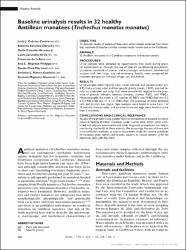| License | CC BY-NC | es |
| Author | Cabrias-Contreras, Lesly J. | |
| Author | Sánchez-Okrucky, Roberto | |
| Author | Caicedo-Herrera, Dalila | |
| Author | Jaramillo-Ortíz, Laura | |
| Author | Rosa, Francisco de la | |
| Author | Negrete-Philippe, Ana C. | |
| Author | Cruz-Martínez, Danilo | |
| Author | Rivera-Guzmán, Antonio L. | |
| Author | Mignucci-Giannoni, Antonio | |
| Accessioned date | 2024-06-15T16:24:17Z | |
| Available date | 2024-06-15T16:24:17Z | |
| Year | 2021 | |
| Citation | Cabrias-Contreras, L. J., Sánchez-Okrucky, R., Caicedo-Herrera, D., Jaramillo-Ortíz, L., De la Rosa, F., Negrete-Philippe, A. C., ... & Mignucci-Giannoni, A. (2021). Baseline urinalysis results in 32 healthy Antillean manatees (Trichechus manatus manatus). Journal of the American Veterinary Medical Association, 258(4), 416-424. Recuperado de: | es |
| URI | https://bvearmb.do/handle/123456789/4706 | |
| Abstract | Objective: To describe results of analysis of free-catch urine samples collected from Antillean manatees (Trichechus manatus manatus) under human care in the Caribbean.
Animals: 32 Antillean manatees in 5 Caribbean oceanaria and rescue centers.
Procedures: Urine samples were obtained by opportunistic free catch during physical examination or through the use of operant conditioning procedures. Urinalyses consisted of macro- and microscopic evaluations, biochemical analyses with test strips, and refractometry. Results were compared for manatees grouped on the basis of age, sex, and habitat.
Results: Urine samples were typically clear, straw colored, and alkaline (mean pH, 8.0); had a urinoid odor and low specific gravity (mean, 1.010); and had results on qualitative test strips that were consistently negative for the presence of glucose, bilirubin, ketones, proteins, nitrites, RBCs, and WBCs. Microscopically, the mean ± SD number of RBCs and WBCs/hpf was 0.5 ± 0.3 RBCs/hpf and 1.1 ± 1.5 WBCs/hpf. The presence of some epithelial cells and crystals was typical. Spermatozoa were found in urine from 1 of 15 sexually mature males, and parasite larvae and eggs were found in urine from 2 manatees.
Conclusions and clinical relevance: Results of the present study yielded the first compilation of baseline urinalysis values in healthy Antillean manatees under human care, which, when combined with physical examination and other diagnostic procedures, can help in monitoring the health of these animals. We encourage the use of free-catch urine collection methods, as used in the present study, for routine urinalyses of manatees under human care in zoos, aquaria, or rescue centers. | es |
| Language | English | es |
| Published | Journal of the American Veterinary Medical Association, 258(4), 416-424 | es |
| Rights | © Journal of the American Veterinary Medical Association. Available at: https://avmajournals.avma.org/ | es |
| Rights URI | https://creativecommons.org/licenses/by-nc/4.0/ | es |
| Subject | Biodiversidad - República Dominicana | es |
| Subject | Fauna ─ República Dominicana | es |
| Subject | Mamíferos marinos | es |
| Title | Baseline urinalysis results in 32 healthy Antillean manatees (Trichechus manatus manatus) | es |
| dc.identifier.doi | https://doi.org/10.2460/javma.258.4.416 | |
| Material type | Article | es |
| Type of content | Scientific research | es |
| Access | Open | es |
| Audience | Technicians, professionals and scientists | es |


